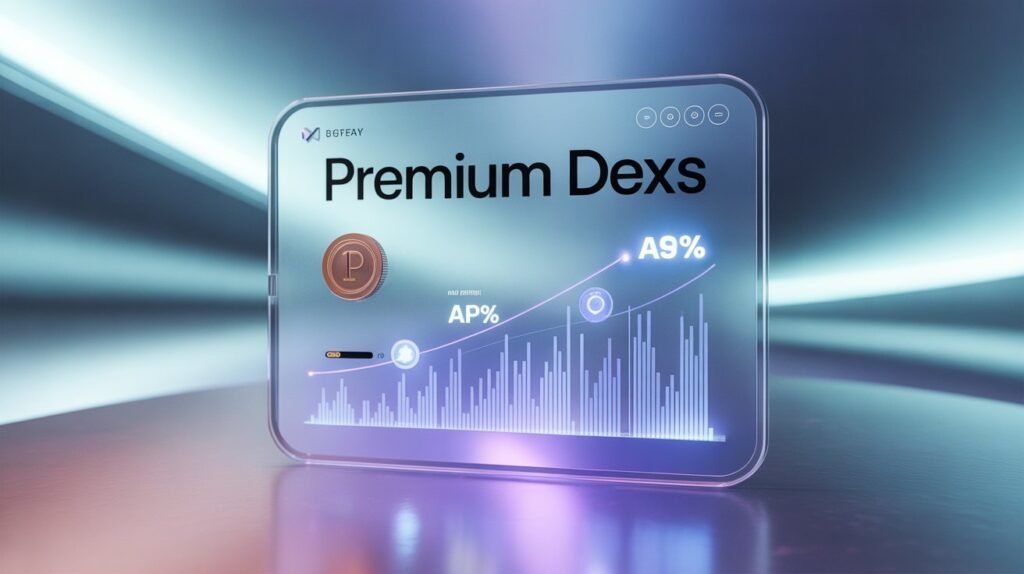Premium decentralized exchanges have evolved beyond simple trading platforms to become powerful passive income generators. Many top-tier DEXs now offer integrated vault strategies, liquidity mining programs, and yield farming opportunities that can deliver impressive annual percentage yields ranging from 15% to over 100%. These platforms combine the benefits of decentralized trading with sophisticated yield optimization tools that automatically compound rewards and maximize returns.
A DEX with integrated crypto vault strategies can generate substantial passive income through automated yield farming, liquidity provision, and staking rewards without requiring constant monitoring. Users can deposit their crypto assets into various pools and vaults, where smart contracts automatically allocate funds to the highest-yielding opportunities across different protocols. This hands-off approach allows investors to benefit from complex trading strategies and arbitrage opportunities typically reserved for professional traders.
The key to maximizing returns lies in understanding how these yield-generating products work and selecting the right platforms based on security, APY rates, and fee structures. Different DEXs offer varying reward mechanisms, from simple liquidity pool rewards to complex multi-strategy vaults that dynamically adjust positions based on market conditions. By exploring these premium platforms and their unique features, investors can build diversified passive income streams that outperform traditional savings accounts and many traditional investment vehicles.
Top Premium DEXs for Passive Income with High APY
Premium decentralized exchanges provide traders with multiple ways to earn passive income through liquidity provision, yield farming, and staking programs. These platforms offer competitive annual percentage yields while maintaining strong security and user-friendly interfaces.
Uniswap: Earn Rewards Through Liquidity Pools
Uniswap stands as the largest decentralized exchange by trading volume. Users can earn passive income by providing liquidity to trading pairs.
The platform operates on an automated market maker model. Liquidity providers deposit equal values of two tokens into pools. They earn a portion of the transaction fees generated from trades.
Popular High-Yield Pools:
- ETH/USDC: 0.3% fee tier
- WBTC/ETH: 0.3% fee tier
- DAI/USDC: 0.01% fee tier
Users receive LP tokens representing their share of the pool. These tokens can be staked in various DeFi projects for additional rewards.
The platform’s high trading volume generates substantial fee income for liquidity providers. Daily trading volumes often exceed $1 billion across all pools.
Uniswap V3 introduced concentrated liquidity features. This allows providers to focus their capital within specific price ranges for higher capital efficiency.
PancakeSwap on Binance Smart Chain: High-Yield Staking and Farming
PancakeSwap operates on Binance Smart Chain, offering lower transaction costs than Ethereum-based platforms. The platform provides multiple income streams through farms, pools, and staking.
Yield Farming Options:
- CAKE-BNB LP: 15-25% APY
- BUSD-BNB LP: 12-20% APY
- Various altcoin pairs: 20-50% APY
Users can stake CAKE tokens in syrup pools to earn other tokens. These pools regularly feature new defi projects launching on BSC.
The platform’s native CAKE token provides additional utility. Holders can participate in governance voting and access exclusive features.
PancakeSwap’s lottery and prediction games offer alternative earning methods. The platform burns CAKE tokens weekly to maintain price stability.
Low fees on Binance Smart Chain make frequent compounding profitable. Users can reinvest earnings without losing significant value to transaction costs.
SushiSwap: Passive Income from Multiple DeFi Products
SushiSwap began as a Uniswap fork but evolved into a comprehensive DeFi ecosystem. The platform offers liquidity provision, yield farming, and additional earning products.
Income Streams:
- Liquidity pools with 0.25% trading fees
- SUSHI token staking (xSUSHI)
- Onsen farms for new token launches
- Kashi lending markets
The SUSHI token provides governance rights and fee sharing. Stakers receive xSUSHI tokens that appreciate as fees accumulate.
SushiSwap operates across multiple blockchains. Users can provide liquidity on Ethereum, Polygon, Arbitrum, and other networks.
The platform’s Onsen program incentivizes liquidity for new projects. These farms often offer higher APY rates but carry additional risks.
Kashi lending allows users to earn interest on deposited assets. The isolated market design reduces risks compared to pooled lending protocols.
Balancer: Optimized Automated Market Making and Custom Pools
Balancer allows users to create custom liquidity pools with flexible token weightings. This flexibility enables more sophisticated passive income strategies.
Pool Types:
- Weighted pools (80/20, 60/40 ratios)
- Stable pools for similar assets
- Boosted pools with improved yields
- Managed pools with dynamic weights
The platform’s BAL token rewards liquidity providers through liquidity mining programs. Users can stake BAL tokens for additional fee sharing.
Balancer’s smart order routing optimizes trades across multiple pools. This increases trading volume and fee generation for liquidity providers.
The platform supports up to 8 tokens per pool. This allows for diversified exposure while earning trading fees.
Yield Boosting Features:
- Gauge voting for BAL emissions
- veBAL locking for increased rewards
- Boosted pools with Aave integration
Users can vote on BAL token distributions across different pools. This governance mechanism influences where the highest yields are available.
How Yield-Generating Products Work on DEXs
Premium DEXs generate passive income through three main methods: staking mechanisms that reward users with tokens, yield farming strategies that pool assets for maximum returns, and lending protocols that earn interest on deposited crypto assets.
Staking Mechanisms and APR/APY Explanation
Staking allows users to lock their crypto assets in smart contracts to earn rewards. The process works by depositing tokens into staking pools, where they help secure the blockchain network or provide liquidity.
APR vs APY differences:
- APR (Annual Percentage Rate): Simple interest calculated yearly
- APY (Annual Percentage Yield): Compound interest that includes reinvested earnings
Most premium DEXs offer proof-of-stake rewards ranging from 5% to 25% APY. Users stake tokens like ETH on the Ethereum blockchain to earn staking rewards paid in the same token.
The rewards come from network fees and newly minted tokens. Staking tokens typically have lock-up periods from 7 days to several months. Higher APY rates often mean higher risks or longer lock periods.
Users can stake single tokens or liquidity provider tokens. Smart contracts automatically distribute rewards based on the amount staked and time held.
Yield Farming Strategies and Vaults
Yield farming involves providing liquidity to DEX pools to earn multiple token rewards. Users deposit crypto assets into liquidity pools and receive fees from trades, plus bonus tokens.
Common yield farming strategies:
- Single-asset deposits: Stake one token type
- Liquidity pairs: Provide two tokens to the trading pools
- Multi-pool farming: Spread assets across different pools
Vaults automate the yield farming process by moving funds between different opportunities. These smart contracts find the best APY rates and automatically compound earnings.
Yield aggregator platforms scan multiple DEXs to find optimal returns. They handle complex strategies like harvesting rewards and reinvesting profits without manual work.
Popular vault strategies include stablecoin farming with USDC pairs and volatile token combinations. Users deposit once, and the vault handles all optimization automatically.
Lending and Borrowing for Extra Income
Lending protocols allow users to deposit crypto assets and earn interest from borrowers. The system works through smart contracts that match lenders with borrowers automatically.
Users deposit tokens into lending pools and receive interest-bearing tokens in return. Interest rates change based on supply and demand for each asset type.
Lending benefits:
- Passive income: Earn interest without active trading
- Flexible withdrawals: Remove funds when needed
- Multiple assets: Lend different cryptocurrencies
Borrowing creates additional yield opportunities through leveraged strategies. Users can borrow against their deposits to farm other protocols while keeping their original assets.
Interest rates for lending typically range from 2% to 15% APY, depending on the asset. Stablecoins like USDC often provide more stable returns than volatile tokens.
Smart contract vulnerabilities present risks in lending protocols. Users should research platform security and start with smaller amounts to test the system.
Conclusion
Premium DEXs offer diverse strategies for generating passive income with attractive APY rates. Yield farming, liquidity provision, and staking remain the most popular methods for earning returns on crypto assets.
Investors should balance potential rewards against risks like impermanent loss and market volatility. Automated yield aggregators provide hands-off solutions for users seeking passive income without active management.
The DeFi space continues evolving in 2025, with new opportunities emerging across multiple protocols and platforms. Success requires understanding each strategy’s risk profile and choosing approaches that match individual investment goals.


